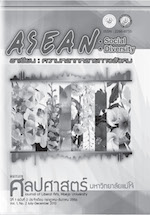โลกทัศน์ชาวไทลื้อ: มุมมองจากคำสี่พยางค์ (World View of the Tai Lue: A Perspective from the Four Syllable Words)
Main Article Content
Abstract
ผลการวิจัยพบว่า คำสี่พยางค์สะท้อนโลกทัศน์ 3 ประการ ได้แก่ โลกทัศน์ เรื่องการปกครองและการแบ่งชนชั้น คำสี่พยางค์ปรากฏในช่วง พ.ศ. 2400-พ.ศ. 2500 สะท้อนให้เห็นว่าการปกครองของชาวไทลื้อเป็นการปกครองแบบเจ้าฟ้าเจ้าแผ่นดินและมีการแบ่งชนชั้นทางสังคมด้วยการใช้ตำแหน่งทางการปกครองเป็นเกณฑ์ แต่ช่วง พ.ศ. 2501-พ.ศ. 2530 และช่วงพ.ศ. 2531-พ.ศ. 2551 เกณฑ์ในการแบ่งชนชั้นของคนในสังคมมีเพิ่มขึ้นคือ ความรู้ ความร่ำรวย และวัย โลกทัศน์ประการที่สองคือ โลกทัศน์เรื่องศาสนาและความเชื่อ คำสี่พยางค์ที่ปรากฏในทุกช่วงสมัยสะท้อนให้เห็นว่า ชาวไทลื้อทุกยุคสมัยนับถือพุทธศาสนาควบคู่ไปกับการนับถือผีโดยมีความเชื่อในเรื่องของบุญบาป ภพชาติ และกรรมเวร ตามหลักธรรมของพระพุทธศาสนาและมีการเคารพบูชาผีบรรพบุรุษสำหรับโลกทัศน์ประการสุดท้ายคือ โลกทัศน์เรื่อง วิถีชีวิตความเป็นอยู่ของชาวไทลื้อ สะท้อนให้เห็นว่าชาวไทลื้อในทุกยุคสมัยประกอบอาชีพเกษตรกรรมเป็นหลัก ในขณะเดียวกันก็มีการประกอบอาชีพค้าขายและเลี้ยงสัตว์
The purpose of this research was to study the four syllable words in the Tai Lue language by studying world view of Tai Lue people towards the four syllable words. The study was conducted by using the 3 eras of data from Tai Lue documentaries and the interview of Tai Lue natives residing in the Sipsongpanna. The timing of this study was from the year 2400 B.E. to 2500 B.E., 2501 B.E. to 2530 B.E. and 2531 B.E. to 2551 B.E.
It was found that the four syllable words reflected the world view in 3 aspects namely governance and social stratification, religion and beliefs and lifestyles of the Tai Lue. The first view is the different class system in the Tai Lue society which shows that during 2400 B.E. to 2500 B.E. was governed by a monarchy system. Society was divided according to different governmental positions. But from 2501 B.E. to 2530 B.E. and 2531 B.E. to 2551 B.E., it became divided in different classes according to the knowledge, wealth, and age of the population. As for their second perspective for their beliefs, there was an evidence that they were a Buddhist society which also worshipped necromancy with a strong belief in karma, reincarnation and deceased ancestors. Moreover their final perspective for the lifestyles of the Tai Lue society, it can be seen that in every generation the main career within the society is consisted of agricultural activities in addition to tradesmen and animal herders.

